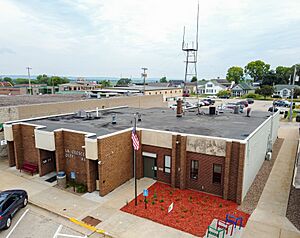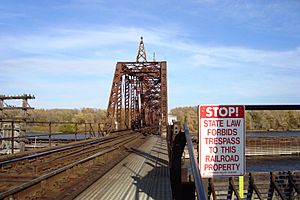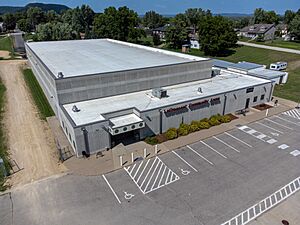La Crescent, Minnesota facts for kids
Quick facts for kids
La Crescent
|
|
|---|---|

City hall
|
|
| Nickname(s):
"Apple Capital of Minnesota"
|
|

|
|
| Country | United States |
| State | Minnesota |
| Counties | Houston, Winona |
| Founded | 1851 |
| Government | |
| • Type | Mayor – Council |
| Area | |
| • Total | 3.82 sq mi (9.90 km2) |
| • Land | 3.33 sq mi (8.61 km2) |
| • Water | 0.50 sq mi (1.29 km2) |
| Elevation | 682 ft (208 m) |
| Population
(2020)
|
|
| • Total | 5,276 |
| • Estimate
(2021)
|
5,274 |
| • Density | 1,586.77/sq mi (612.64/km2) |
| Time zone | UTC-6 (CST) |
| • Summer (DST) | UTC-5 (CDT) |
| ZIP code |
55947
|
| Area code(s) | 507 |
| FIPS code | 27-33866 |
| GNIS feature ID | 2395562 |
La Crescent (pronounced lə KRESS-ənt) is a city in the state of Minnesota, USA. It is located in both Houston and Winona counties. In 2020, about 5,276 people lived there.
La Crescent is special because it's known as the "Apple Capital of Minnesota." This is because a man named John S. Harris planted many apple trees here a long time ago. Today, you can still find many apple orchards in the city. The city is also recognized for its efforts to be green. It's a 'Tree City' and a 'Minnesota GreenStep City'.
Contents
History of La Crescent
La Crescent is on the west bank of the Mississippi River. It is surrounded by tall hills called bluffs. These bluffs offer amazing views of the river and lots of wildlife. People have lived in this area for thousands of years. Before European settlers arrived, the Dakota people and the Ho-Chunk (also known as Winnebago) lived here.
Early Exploration and Settlement
After the Louisiana Purchase in 1803, explorers began mapping this land. Nathan Boone, who was the youngest son of the famous Daniel Boone, was one of the first to survey the area. In the 1840s, the Native American tribes who lived here were moved away. This made room for white settlers to build new homes.
La Crescent was founded in 1851 by Peter and Emma Cameron. They first called the town "Camerons." Peter Cameron was a very interesting person. He tried to dig a canal to change the path of the Mississippi River. He wanted the river to flow closer to La Crescent and away from La Crosse, Wisconsin, which is across the river. He died just before his canal was supposed to be finished in 1857. The canal was never completed, but you can still see its path from above today.
Changing Names and Growth
The town's name changed quickly. William and Harvey Gillett named it "Manton" after clearing the downtown area. Then, a land company called the Kentucky Land Company changed the name again. They wanted a more romantic name to attract new settlers. They chose "La Crescent" because of the "crescent" or curved shape of the Mississippi River around the town. La Crescent officially became a city in 1857.
The Apple Capital Story
In 1856, a plant expert named John S. Harris came to La Crescent. He is the reason the city is known as the "Apple Capital of Minnesota." Many people thought apples could not grow in Minnesota's cold winters. But Harris believed they could.
In 1857, he planted the first apple trees in the area. He tried many different types of apples until he found ones strong enough for Minnesota's weather. He planted thousands of apple trees and hundreds of varieties. He said about half of them didn't work out. Harris became known as the "Father of the Orchardists" in Minnesota. He also helped start the Minnesota State Horticultural Society. In 2002, La Crescent officially copyrighted its title as the "Apple Capital of Minnesota."
Geography of La Crescent
The city of La Crescent covers about 3.47 square miles (9.0 square kilometers). Most of this area is land, about 2.94 square miles (7.6 square kilometers). The rest, about 0.53 square miles (1.4 square kilometers), is water.
La Crescent is located about three miles southwest of Onalaska, Wisconsin. It is also west of the northern part of La Crosse. The city of Winona, Minnesota is about 21 miles northwest of La Crescent. La Crescent is the biggest city in Houston County. It is also the second largest city in Winona County.
Bluffs and Hills
La Crescent is famous for its many bluffs. These are steep hills that rise above the land. The city itself sits on the side of a large bluff. Other big hills are also found within the city limits. Being next to these bluffs helps protect La Crescent from strong winds.
Blue Lake
La Crescent is also next to Blue Lake. The US Fish and Wildlife Service says this lake is a high-quality wetland. It has many different types of plants and animals. People can fish in Blue Lake all year round.
You can often see many migratory birds around the lake. These include Wood Ducks, Ruddy Ducks, and Sandhill Cranes. In the early spring, the water is very clear. Later, natural water plants grow and cover the surface.
Population and People
| Historical population | |||
|---|---|---|---|
| Census | Pop. | %± | |
| 1870 | 380 | — | |
| 1880 | 326 | −14.2% | |
| 1910 | 372 | — | |
| 1920 | 373 | 0.3% | |
| 1930 | 520 | 39.4% | |
| 1940 | 815 | 56.7% | |
| 1950 | 1,229 | 50.8% | |
| 1960 | 2,624 | 113.5% | |
| 1970 | 3,296 | 25.6% | |
| 1980 | 3,674 | 11.5% | |
| 1990 | 4,311 | 17.3% | |
| 2000 | 4,923 | 14.2% | |
| 2010 | 4,830 | −1.9% | |
| 2020 | 5,276 | 9.2% | |
| 2021 (est.) | 5,274 | 9.2% | |
| U.S. Decennial Census 2020 Census |
|||
2010 Census Information
In 2010, there were 4,830 people living in La Crescent. There were 2,012 households and 1,370 families. The city had about 1,643 people per square mile.
Most of the people in La Crescent were White (96.5%). There were also smaller groups of African American, Native American, and Asian residents. About 1.1% of the population was Hispanic or Latino.
About 30.7% of households had children under 18 living with them. Most households (55.2%) were married couples. The average household had 2.37 people. The average family had 2.86 people.
The average age in the city was 42.8 years old. About 23.5% of residents were under 18. About 16.6% were 65 years or older. There were slightly more females (52.3%) than males (47.7%).
Education in La Crescent
La Crescent has several schools for its young people. The largest public school system is the La Crescent–Hokah Public Schools. Melinda Crowley is the superintendent. This district includes La Crescent–Hokah Elementary School and La Crescent–Hokah Secondary School.
Another public school option is the La Crescent Montessori Academy & STEM school. This school serves students from pre-kindergarten all the way through 12th grade. Thomas Pollreis is the Head of School. For private education, there is Crucifixion Catholic Elementary. The La Crescent Public Library is also available for everyone in the community to use.
Notable People from La Crescent
Many interesting people have connections to La Crescent:
- Siri Carpenter (born 1971), a science journalist and editor.
- Eriah Hayes (born 1988), a professional hockey player. He is now the boys hockey coach at La Crescent-Hokah High School.
- Sheldon Jackson (1834–1909), a Presbyterian minister and missionary. He was also a political leader.
- Marguerite Kerrigan (1931–2022), a player in the All-American Girls Professional Baseball League.
- Michelle Rifenberg (born 1957), a politician from Minnesota.
- Ken Tschumper (1950–2024), a Minnesota politician and farmer.
- Al W. Wieser, Jr. (born 1949), a Minnesota state legislator and businessman.
City Infrastructure
Transportation Routes
Several important roads run through La Crescent. These include U.S. Highways 14 and 61. Minnesota State Highway 16 also serves as a main route. The northern edge of La Crescent is close to Interstate 90. The Great River Road, which follows the Mississippi River, also passes through La Crescent.
Bus and Trails
Bus service connects La Crescent to La Crosse. The La Crosse MTU operates 13 bus trips daily through La Crescent.
There is also a walking and biking path called the Wagon Wheel Trail. This trail connects La Crescent to La Crosse. It also links to other trails in Wisconsin, like the Great River Trail.
See also
 In Spanish: La Crescent (Minnesota) para niños
In Spanish: La Crescent (Minnesota) para niños





